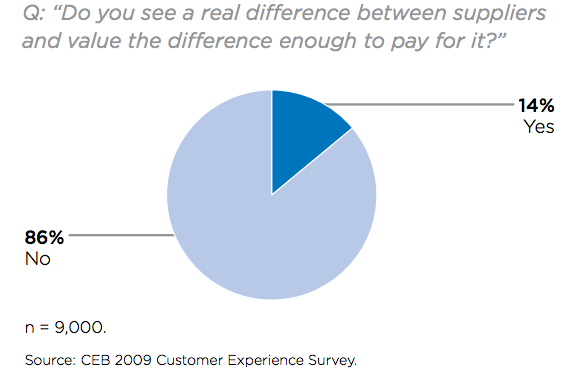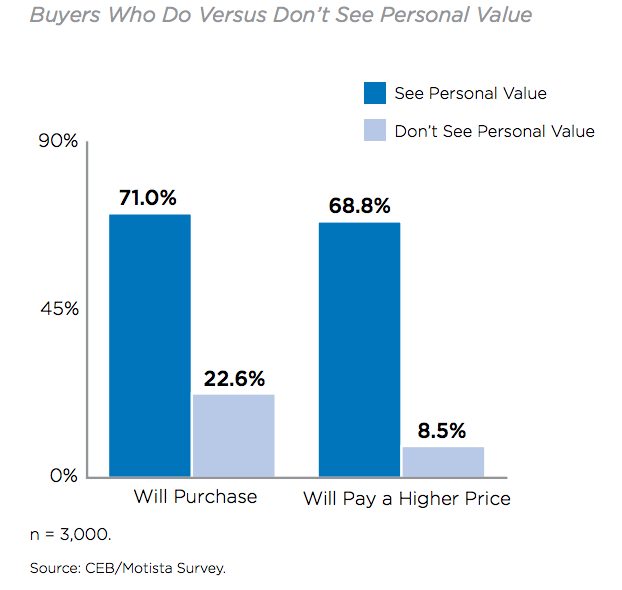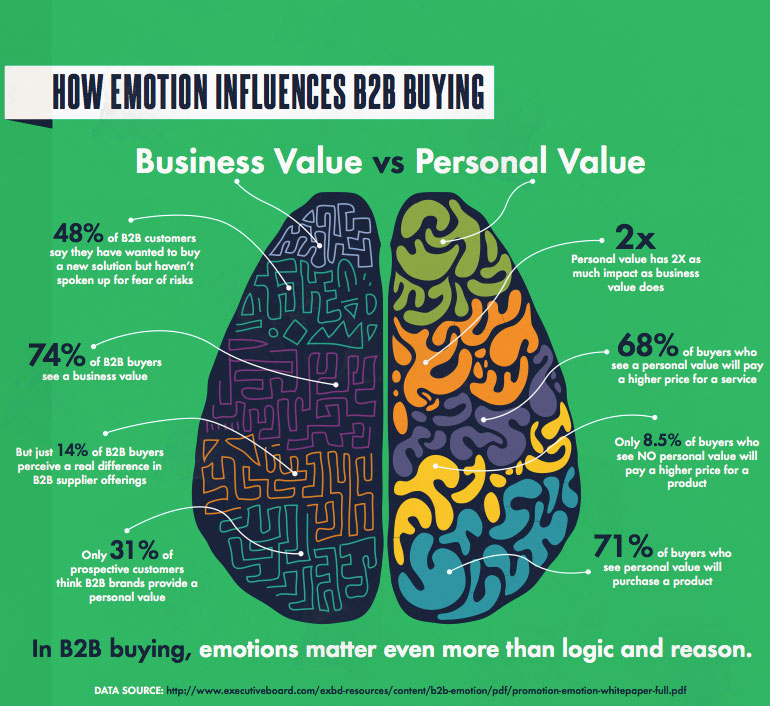A hot prospect has demoed your software or product, and now you’ve got Sales talking with the decision-makers about an enterprise solution that will be your biggest yet. You find out they’ve narrowed down their decision to you and two of your competitors. This should be a slam dunk—you just spent the last three months doing market research and sharpening your Unique Value Proposition (UVP), and you know your team now clearly communicates the unique value you provide.
But the sales process drags out weeks and months. . . and the prospect is asking for discounts and extra customization at no additional charge. You’re crunching the numbers, trying to figure out how to keep the deal alive and asking yourself why you’re stuck competing on price again. And then you find out the prospect chose a competitor.
What went wrong? Your UVP was strong. Your sales team was at the top of their game. What happened?
As it turns out, UVP isn’t as important as we think it is. CEB research surveyed 3,000 B2B buyers across 36 brands and 7 industries and revealed that only 14% of buyers perceive enough meaningful difference between brands’ business value to be willing to pay extra for that difference. Unless you’re selling something truly revolutionary—solving a problem that has not yet been solved in any way, shape, or form—your UVP is pretty much the same as your best competitors’ UVPs. Although there are subtle differences, your prospects are saying they’re not willing to pay for them. So you end up competing on price.

What’s the solution? It’s not that UVP doesn’t matter at all. B2B buyers demand ROI—you have to deliver at least as much business value as your competitors do, in order to get into the consideration set. So all the work you put into developing your UVP isn’t wasted.
Personal Value Beats Business Value
But while nearly all B2B companies focus on business value and treat B2B buying as a rational decision process, the reality is that people are making these buying decisions—people who have emotions and who are concerned about things like getting a promotion, being respected by their peers, and not making mistakes. They fear risk. They want admiration. They are driven by the desire to be successful.
According to CEB’s research, over 90% of the B2B buyers surveyed would either put off the purchase indefinitely or would buy from the lowest-price supplier in their consideration set. If you’re going to consistently win deals profitably, you need to address personal value at least as much as you address business value.

There are two sides to personal value—a positive and a negative. If you tackle both in your marketing and sales materials, you’ll build a strong case that will motivate buyers. Let’s look at each of these in detail.
Address Personal Benefits
The positive side of the personal value coin is personal benefits—how your product or service benefits your prospects personally. While every individual will have his or her own goals and desires, you’ll want to identify two or three that are shared by most of your prospects so you can focus on these in your marketing. (If you break out different market segments or personas and market separately to each, you have the freedom to get more specific with the personal benefits you highlight.)
To identify the personal benefits that will resonate with your prospects, you’ll need to do a bit of research. The easiest way to learn this info is to set up brief phone interviews with current clients or prospects who fit your ideal client profile. Here are a few questions you can ask that will give you insight.
- What is important to you as a [title or role]?
- What are you currently working toward? (A promotion? A role change? You’re looking for what motivates them.)
- What are your one-year goals?
- Where do you see yourself in two years?
Once you’ve completed your interviews, look over the words and phrases that your interviewees used to describe what matters to them. What words and phrases were used the most? These are the ones that you’ll want to incorporate into your messaging to ensure prospects fully understand and instinctively react to what you’re saying.
Address Personal Risk
The negative side of the personal value coin is personal risk. Fear is one of the strongest forces that prevent people from taking action—even action they logically know they need to take. If you want prospects to move forward in the buying journey, you’re going to have to address their fears.
Nearly every B2B buyer, no matter what his or her job role, has the following fears.
- Potential loss of time. Would-be buyers are busy and almost always have more on their to-do lists than they can possibly get done. They worry that implementing your solution will take up too much of their valuable time.
- Potential loss of respect. To get the deal agreed upon, buyers have to champion your solution to their teams. They worry that if your solution doesn’t deliver as promised, or if it’s a nightmare to implement, they’ll lose the support of coworkers and superiors.
- Potential loss of job. If the performance of your product or service is bad enough and causes a large loss of money or potential revenue, a buyer could lose his or her job over the purchase. This is a fear that can easily and completely derail a purchase.
If you want to close the deal, you’ll need to address each of these fears in your bottom-of-the-funnel marketing content or sales materials.

It’s important to note that “showing” is more effective than “telling” prospects that they don’t need to worry about these potential hazards. Besides that fact that it would be weird, no one would believe you if you simply stated, “And there’s no reason to fear losing your job if you buy from us—you won’t!”
Use testimonials and case studies to demonstrate the results you’ve achieved for other companies similar to theirs. Point out how quickly or easily the implementation went and the specific ROI you delivered. Social proof (especially if you’ve got testimonials or case studies from companies well-known in their industry) will alleviate their fears better than anything else.
Dig into the Pain of Non-action
The best way to overcome that last bit of doubt remaining after you’ve addressed potential fears is to dig into the pain that will result from not moving forward with the purchase.
Find out what the buyer will lose if he or she puts off the decision, and quantify it. How much revenue is he or she sacrificing? How much time is he or she wasting?
Then compare the loss resulting from inaction to any remaining potential risk. You need to show the buyer that the reward greatly outweighs any potential risk. This is the final kick-in-the-pants that buyers need to make the purchase.
The best time to point out the pain of non-action is in your proposal. After you’ve clearly communicated business benefits and personal benefits, and after you’ve assuaged their fears, make sure they feel how much the status quo hurts—and how that pain will just continue to get worse the longer they stay there.
Never Forget You’re Selling to People
The companies that win will be the companies that thoroughly understand their prospects and clearly communicate personal value as well as business value. Never lose sight of the fact that, even as a B2B company, you’re selling to people. Show off that shiny UVP, but don’t stop the conversation at business value. And you’ll find that price is no longer holding you back from those highly-coveted enterprise deals.
About the Author: Laura MacPherson is a freelance writer who integrates persuasion psychology and research into copywriting and content for B2B companies. Follow her (or connect) on LinkedIn for an unlimited supply of marketing tips and tricks.